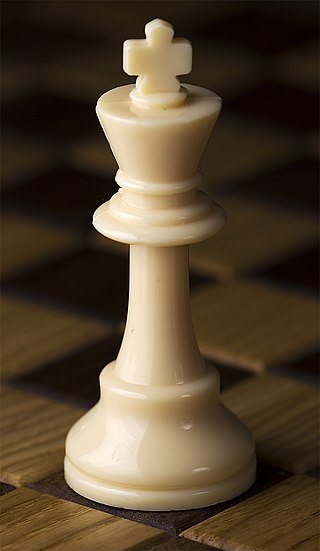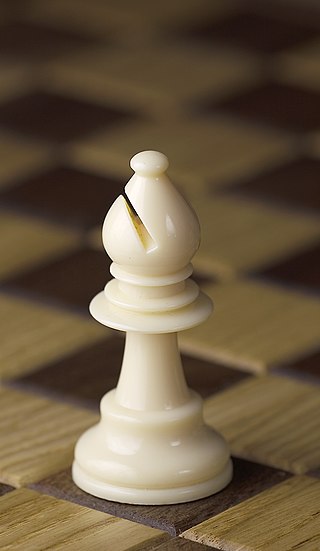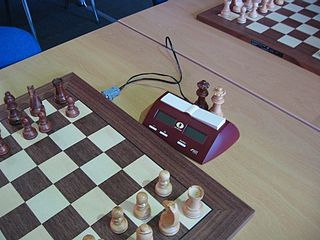Chess strategy is the aspect of chess play concerned with evaluation of chess positions and setting goals and long-term plans for future play. While evaluating a position strategically, a player must take into account such factors as the relative value of the pieces on the board, pawn structure, king safety, position of pieces, and control of key squares and groups of squares. Chess strategy is distinguished from chess tactics, which is the aspect of play concerned with the move-by-move setting up of threats and defenses. Some authors distinguish static strategic imbalances, which tend to persist for many moves, from dynamic imbalances, which are temporary. This distinction affects the immediacy with which a sought-after plan should take effect. Until players reach the skill level of "master", chess tactics tend to ultimately decide the outcomes of games more often than strategy. Many chess coaches thus emphasize the study of tactics as the most efficient way to improve one's results in serious chess play.

The king is the most important piece in the game of chess. It may move to any adjoining square; it may also perform a move known as castling. If a player's king is threatened with capture, it is said to be in check, and the player must remove the threat of capture on the next move. If this cannot be done, the king is said to be in checkmate, resulting in a loss for that player. A player cannot make any move that places their own king in check. Despite this, the king can become a strong offensive piece in the endgame or, rarely, the middlegame.

The queen is the most powerful piece in the game of chess. It can move any number of squares vertically, horizontally or diagonally, combining the powers of the rook and bishop. Each player starts the game with one queen, placed in the middle of the first rank next to the king. Because the queen is the strongest piece, a pawn is promoted to a queen in the vast majority of cases.

The bishop is a piece in the game of chess. It moves and captures along diagonals without jumping over intervening pieces. Each player begins the game with two bishops. One starts between the king's knight and the king, the other between the queen's knight and the queen. The starting squares are c1 and f1 for White's bishops, and c8 and f8 for Black's bishops.
In chess, a fork is a tactic in which a piece attacks multiple enemy pieces simultaneously. The attacker usually aims to capture one of the forked pieces. The defender often cannot counter every threat. A fork is most effective when it is forcing, such as when the king is put in check. A fork is a type of double attack.
In chess, a pin is a tactic in which a defending piece cannot move out of an attacking piece's line of attack without exposing a more valuable defending piece. Moving the attacking piece to effect the pin is called pinning; the defending piece restricted by the pin is described as pinned. Only a piece that can move any number of squares along a horizontal, vertical, or diagonal line can pin. Any piece can be pinned except the king, which is the most valuable piece. The inverse of a pin is a skewer, in which a more valuable piece under direct attack may move to expose a less valuable piece to an attack.

Algebraic notation is the standard method for recording and describing the moves in a game of chess. Also called standard notation, it is based on coordinate notation, a system of coordinates to uniquely identify each square on the chessboard. It is used by most books, magazines, and newspapers. In English-speaking countries, the parallel method of descriptive notation was generally used in chess publications until about 1980. A few players still use descriptive notation, but it is no longer recognized by FIDE, the international chess governing body.

The rules of chess govern the play of the game of chess. Chess is a two-player abstract strategy board game. Each player controls sixteen pieces of six types on a chessboard. Each type of piece moves in a distinct way. The object of the game is to checkmate the opponent's king. A game can end in various ways besides checkmate: a player can resign, and there are several ways a game can end in a draw.
Descriptive notation is a chess notation system based on abbreviated natural language. Its distinctive features are that it refers to files by the piece that occupies the back rank square in the starting position and that it describes each square two ways depending on whether it is from White or Black's point of view. It was common in English, Spanish and French chess literature until about 1980. In most other languages, the more concise algebraic notation was in use. Since 1981, FIDE no longer recognizes descriptive notation for the purposes of dispute resolution, and algebraic notation is now the accepted international standard.
This glossary of chess explains commonly used terms in chess, in alphabetical order. Some of these terms have their own pages, like fork and pin. For a list of unorthodox chess pieces, see Fairy chess piece; for a list of terms specific to chess problems, see Glossary of chess problems; for a list of named opening lines, see List of chess openings; for a list of chess-related games, see List of chess variants; for a list of terms general to board games, see Glossary of board games.
In chess, the term X-ray or X-ray attack is sometimes used as a synonym for skewer. It can also refer to a tactic where a piece either:
In chess, a tactic is a sequence of moves that each makes one or more immediate threats – a check, a material threat, a checkmating sequence threat, or the threat of another tactic – which culminates in the opponent's being unable to respond to all of the threats without making some kind of concession. Most often, the immediate benefit takes the form of a material advantage or mating attack; however, some tactics are used for defensive purposes and can salvage material that would otherwise be lost, or to induce stalemate in an otherwise lost position.
In chess and other related games, a double check is a check delivered by two pieces simultaneously. In chess notation, it is almost always represented the same way as a single check ("+"), but is sometimes symbolized by "++". This article uses "++" for double check and "#" for checkmate.
Handicaps in chess are handicapping variants which enable a weaker player to have a chance of winning against a stronger one. There are a variety of such handicaps, such as material odds, extra moves, extra time on the chess clock, and special conditions. Various permutations of these, such as "pawn and two moves", are also possible.

In chess, promotion is the replacement of a pawn with a new piece when the pawn is moved to its last rank. The player replaces the pawn immediately with a queen, rook, bishop, or knight of the same color. The new piece does not have to be a previously captured piece. Promotion is mandatory; the pawn cannot remain as a pawn.
In chess, a sacrifice is a move that gives up a piece with the objective of gaining tactical or positional compensation in other forms. A sacrifice could also be a deliberate exchange of a chess piece of higher value for an opponent's piece of lower value.
Yari shogi is a modern variant of shogi ; however, it is not Japanese. It was invented in 1981 by Christian Freeling of the Netherlands. This game accentuates shogi’s intrinsically forward range of direction by giving most of the pieces the ability to move any number of free squares orthogonally forward like a shogi lance. The opposite is true of promoted pieces which can move backward with the same power.
The Exchange Variation of the Ruy Lopez is a chess opening that begins with the moves:

In chess, several checkmate patterns occur frequently enough to have acquired specific names in chess commentary. By definition, a checkmate pattern is a recognizable/particular/studied arrangements of pieces that delivers checkmate. The diagrams that follow show these checkmates with White checkmating Black.

The following outline is provided as an overview of and topical guide to chess:








